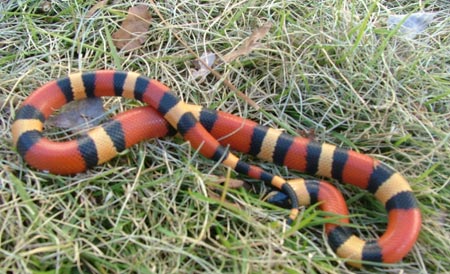Decipher the mystery of snakes' ability to crawl
American scientists have found the secret to help snakes crawl on smooth surfaces. The discovery helps us solve one of the oldest mysteries, while helping engineers design more modern search and rescue robots.

Pueblan milk snake.Photo: bcsnakes.com.
The whole body is covered with scales, but their scales are completely different from fish scales. Snake scales are because the stratum corneum in the outermost part of the skin turns into so-called horn scales, while the scales of the majority of fish are the innermost layer of the skin that turns into. Solid scales supple, waterproof. The development of scales does not correspond to the growth of the body. Snakes grow up by molting. After each molting, the scale will be slightly larger than the old one. Snake scales, not only prevent the evaporation of water, help the body avoid injury, but also help them move.
Scales on the snake's body have two types: abdominal scales (in the middle of the abdomen, relatively large and rectangular) and body scales (smaller than the abdominal scales and located on the dorsal scales to the dorsal side). Abdominal scales connect with ribs through rib muscles.
Snakes do not have malignant bones, so the ribs can move freely in both directions before and after. When the rib muscles contract, the ribs move forward, causing the abdominal scales to rise slightly. The sharp end of the scales rubs against the underlying objects, pushing the body forward in a wave shape.
Many snake-makers take advantage of the friction of rocks, garbage and other objects when crawling over rough terrain. But no one can explain why they move on smooth or smooth surfaces - where friction is small or does not exist. David Hu - an animal movement expert from the Georgia Institute of Technology (USA) - said he and his colleagues found the answer.
The team conducted anesthesia for 10 Pueblan milk snakes (venomous snakes, an average of 35 cm long, with red, black, yellow and white bands on the body). After the anesthetic works, they calculate the force they need to create to crawl in many directions. The results show that the force that the snake needs to move sideways is twice that of its force to move forward but is 50% of the force that the snake creates to back.
The team also recorded solid movements for analysis. They noticed some parts of their bodies lifting slightly from the lower surface when moving. This procedure helps the snake reduce unnecessary rubbing, while creating greater pressure on the parts that are pushing them forward. When Hu combined the two movements into the computer model, he found that the virtual snake crawled fast and smoothly like a real snake.
Lakshminarayanan Mahadevan, a Harvard mathematician (USA), studied snake movements for many years. He said the scientists knew about the friction properties of snakes since the 40s of the last century, but Hu was the first to combine the lifting and rubbing operations to explain the secrets of snakes.
Hu's discovery can help engineers design search and rescue robots in collapsed buildings whenever there is an earthquake or war. Previously, inventors created many solid-shaped robots, but they could not move on smooth surfaces. Hu thinks robots can do that if they are encased in leather that can mimic solid scales.
- Strange little known about snakes
- How to deal with snakes crawling into bed, getting into a washing machine?
- Miraculous ability of sea snakes
- Decipher the mystery of
- Decipher the mystery of the profession of spiritual detective in history
- The shocking discovery of snakes and evolution of the human eye
- Why are people afraid of snakes?
- Strengthens secrets to help snakes swallow big snakes
- Poisonous snakes in Vietnam
- The truth about 11 extremely poisonous snakes in the world
- Decipher the mystery of bacteria living half a million years
- 7 snakes look scary ... but harmless to humans
 Animal 'suffering' after hibernation
Animal 'suffering' after hibernation Why do goats climb well?
Why do goats climb well? Scientists were surprised to see chimpanzees eating turtles
Scientists were surprised to see chimpanzees eating turtles Giant catfish died deadly due to drought in Thailand
Giant catfish died deadly due to drought in Thailand